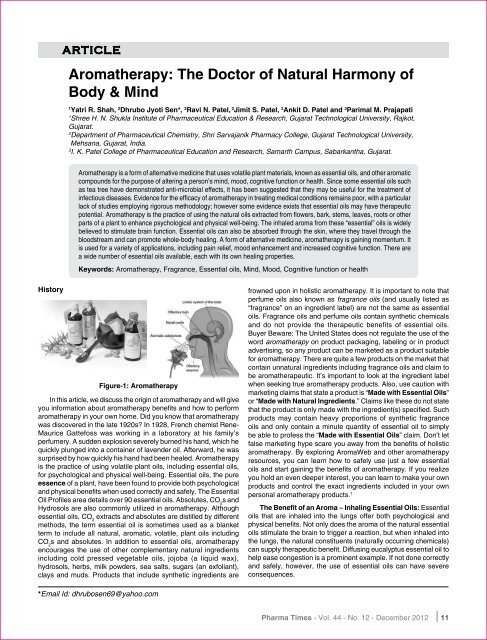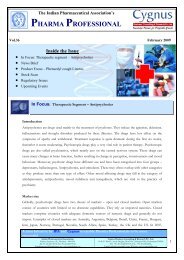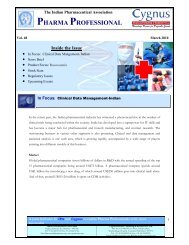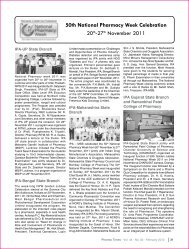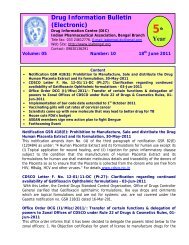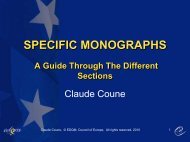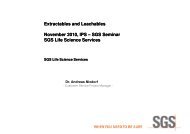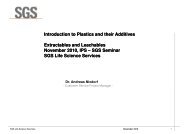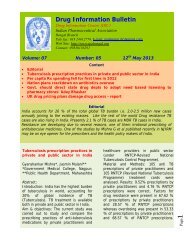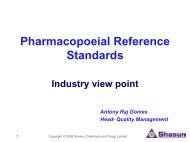Aromatherapy: The Doctor of Natural Harmony of Body & Mind
Aromatherapy: The Doctor of Natural Harmony of Body & Mind
Aromatherapy: The Doctor of Natural Harmony of Body & Mind
Create successful ePaper yourself
Turn your PDF publications into a flip-book with our unique Google optimized e-Paper software.
Article<br />
<strong>Aromatherapy</strong>: <strong>The</strong> <strong>Doctor</strong> <strong>of</strong> <strong>Natural</strong> <strong>Harmony</strong> <strong>of</strong><br />
<strong>Body</strong> & <strong>Mind</strong><br />
1<br />
Yatri R. Shah, 2 Dhrubo Jyoti Sen*, 2 Ravi N. Patel, 2 Jimit S. Patel, 2 Ankit D. Patel and 3 Parimal M. Prajapati<br />
1<br />
Shree H. N. Shukla Institute <strong>of</strong> Pharmaceutical Education & Research, Gujarat Technological University, Rajkot,<br />
Gujarat.<br />
2<br />
Department <strong>of</strong> Pharmaceutical Chemistry, Shri Sarvajanik Pharmacy College, Gujarat Technological University,<br />
Mehsana, Gujarat, India.<br />
3<br />
I. K. Patel College <strong>of</strong> Pharmaceutical Education and Research, Samarth Campus, Sabarkantha, Gujarat.<br />
<strong>Aromatherapy</strong> is a form <strong>of</strong> alternative medicine that uses volatile plant materials, known as essential oils, and other aromatic<br />
compounds for the purpose <strong>of</strong> altering a person’s mind, mood, cognitive function or health. Since some essential oils such<br />
as tea tree have demonstrated anti-microbial effects, it has been suggested that they may be useful for the treatment <strong>of</strong><br />
infectious diseases. Evidence for the efficacy <strong>of</strong> aromatherapy in treating medical conditions remains poor, with a particular<br />
lack <strong>of</strong> studies employing rigorous methodology; however some evidence exists that essential oils may have therapeutic<br />
potential. <strong>Aromatherapy</strong> is the practice <strong>of</strong> using the natural oils extracted from flowers, bark, stems, leaves, roots or other<br />
parts <strong>of</strong> a plant to enhance psychological and physical well-being. <strong>The</strong> inhaled aroma from these “essential” oils is widely<br />
believed to stimulate brain function. Essential oils can also be absorbed through the skin, where they travel through the<br />
bloodstream and can promote whole-body healing. A form <strong>of</strong> alternative medicine, aromatherapy is gaining momentum. It<br />
is used for a variety <strong>of</strong> applications, including pain relief, mood enhancement and increased cognitive function. <strong>The</strong>re are<br />
a wide number <strong>of</strong> essential oils available, each with its own healing properties.<br />
Keywords: <strong>Aromatherapy</strong>, Fragrance, Essential oils, <strong>Mind</strong>, Mood, Cognitive function or health<br />
History<br />
Figure-1: <strong>Aromatherapy</strong><br />
In this article, we discuss the origin <strong>of</strong> aromatherapy and will give<br />
you information about aromatherapy benefits and how to perform<br />
aromatherapy in your own home. Did you know that aromatherapy<br />
was discovered in the late 1920s? In 1928, French chemist Rene-<br />
Maurice Gattefoss was working in a laboratory at his family’s<br />
perfumery. A sudden explosion severely burned his hand, which he<br />
quickly plunged into a container <strong>of</strong> lavender oil. Afterward, he was<br />
surprised by how quickly his hand had been healed. <strong>Aromatherapy</strong><br />
is the practice <strong>of</strong> using volatile plant oils, including essential oils,<br />
for psychological and physical well-being. Essential oils, the pure<br />
essence <strong>of</strong> a plant, have been found to provide both psychological<br />
and physical benefits when used correctly and safely. <strong>The</strong> Essential<br />
Oil Pr<strong>of</strong>iles area details over 90 essential oils. Absolutes, CO 2<br />
s and<br />
Hydrosols are also commonly utilized in aromatherapy. Although<br />
essential oils, CO 2<br />
extracts and absolutes are distilled by different<br />
methods, the term essential oil is sometimes used as a blanket<br />
term to include all natural, aromatic, volatile, plant oils including<br />
CO 2<br />
s and absolutes. In addition to essential oils, aromatherapy<br />
encourages the use <strong>of</strong> other complementary natural ingredients<br />
including cold pressed vegetable oils, jojoba (a liquid wax),<br />
hydrosols, herbs, milk powders, sea salts, sugars (an exfoliant),<br />
clays and muds. Products that include synthetic ingredients are<br />
frowned upon in holistic aromatherapy. It is important to note that<br />
perfume oils also known as fragrance oils (and usually listed as<br />
“fragrance” on an ingredient label) are not the same as essential<br />
oils. Fragrance oils and perfume oils contain synthetic chemicals<br />
and do not provide the therapeutic benefits <strong>of</strong> essential oils.<br />
Buyer Beware: <strong>The</strong> United States does not regulate the use <strong>of</strong> the<br />
word aromatherapy on product packaging, labeling or in product<br />
advertising, so any product can be marketed as a product suitable<br />
for aromatherapy. <strong>The</strong>re are quite a few products on the market that<br />
contain unnatural ingredients including fragrance oils and claim to<br />
be aromatherapeutic. It’s important to look at the ingredient label<br />
when seeking true aromatherapy products. Also, use caution with<br />
marketing claims that state a product is “Made with Essential Oils”<br />
or “Made with <strong>Natural</strong> Ingredients.” Claims like these do not state<br />
that the product is only made with the ingredient(s) specified. Such<br />
products may contain heavy proportions <strong>of</strong> synthetic fragrance<br />
oils and only contain a minute quantity <strong>of</strong> essential oil to simply<br />
be able to pr<strong>of</strong>ess the “Made with Essential Oils” claim. Don’t let<br />
false marketing hype scare you away from the benefits <strong>of</strong> holistic<br />
aromatherapy. By exploring AromaWeb and other aromatherapy<br />
resources, you can learn how to safely use just a few essential<br />
oils and start gaining the benefits <strong>of</strong> aromatherapy. If you realize<br />
you hold an even deeper interest, you can learn to make your own<br />
products and control the exact ingredients included in your own<br />
personal aromatherapy products. 1<br />
<strong>The</strong> Benefit <strong>of</strong> an Aroma ~ Inhaling Essential Oils: Essential<br />
oils that are inhaled into the lungs <strong>of</strong>fer both psychological and<br />
physical benefits. Not only does the aroma <strong>of</strong> the natural essential<br />
oils stimulate the brain to trigger a reaction, but when inhaled into<br />
the lungs, the natural constituents (naturally occurring chemicals)<br />
can supply therapeutic benefit. Diffusing eucalyptus essential oil to<br />
help ease congestion is a prominent example. If not done correctly<br />
and safely, however, the use <strong>of</strong> essential oils can have severe<br />
consequences.<br />
*Email Id: dhrubosen69@yahoo.com<br />
Pharma Times - Vol. 44 - No. 12 - December 2012 11
general rule-<strong>of</strong>-thumb is to be wary <strong>of</strong> products that do not list their<br />
ingredients and those that do not boast <strong>of</strong> having pure essential oils.<br />
A note, however, is that some sellers <strong>of</strong> good-quality aromatherapy<br />
blends do not list their ingredients because they are worried that<br />
others may copy their creation. By asking the seller more about<br />
the blend, and listening to how they respond, you should have a<br />
better idea about the quality <strong>of</strong> the blend being sold. Good suppliers<br />
should be happy to provide you with a list <strong>of</strong> the ingredients. <strong>The</strong>y<br />
understand that some individuals must avoid particular oils due to<br />
health problems.<br />
Figure-2: Aroma from essential oils<br />
<strong>The</strong> Benefit <strong>of</strong> Physical Application: Essential oils that<br />
are applied to the skin can be absorbed into the bloodstream.<br />
<strong>The</strong> constituents <strong>of</strong> essential oils can aid in health, beauty and<br />
hygiene conditions. Since essential oils are so powerful and<br />
concentrated, they should never be applied to the skin in their<br />
undiluted form. To apply essential oils to the skin, essential oils<br />
are typically diluted into a carrier such as a cold pressed vegetable<br />
oil, also known as carrier oil. Common carrier oils include sweet<br />
almond oil, apricot kernel oil and grapeseed oil. A more detailed<br />
definition <strong>of</strong> Carrier Oils is found on the what are Carrier Oils page.<br />
A detailed list <strong>of</strong> carrier oils and their properties can be found on the<br />
Carrier Oils Used in <strong>Aromatherapy</strong> properties page. 2<br />
Other Benefits: In addition to therapeutic benefit at the<br />
emotional and physical level, essential oils are helpful in other<br />
applications. Essential oils can be used in household and laundry<br />
cleaners. Some oils act as a natural insect repellent and pesticide.<br />
You may recall using citronella candles during the summer to keep<br />
mosquitoes away. Citronella essential oil is the ingredient in the<br />
candles that is responsible for repelling the mosquitos.<br />
Essential Oil Blends: Essential oils can be blended together<br />
to create appealing and complex aromas. Essential oils can also be<br />
blended for a specific therapeutic application. Essential oils that are<br />
carefully blended with a specific therapeutic purpose in mind may<br />
be referred to as an essential oil syngery. A synergistic essential<br />
oil blend is considered to be greater in total action than each oil<br />
working independently. AromaWeb’s Recipes area <strong>of</strong>fers a variety<br />
<strong>of</strong> recipes and synergies.<br />
About <strong>Aromatherapy</strong> Products: Not all ready-made<br />
aromatherapy products labeled with the word aromatherapy are<br />
pure and natural. Products that contain artificial ingredients do not<br />
provide true aromatherapy benefits. At worst, they provide no benefit<br />
or are harmful. At best, they provide only a fraction <strong>of</strong> the benefit<br />
that natural products supply. Buyers seeking true aromatherapy<br />
products must look at the ingredient label to ensure that the product<br />
does not contain fragrance oils or unpure (chemical) components. A<br />
Figure-3: Essence <strong>of</strong> essential oil from nature<br />
<strong>Aromatherapy</strong> may have origins in antiquity with the use <strong>of</strong><br />
infused aromatic oils, made by macerating dried plant material in<br />
fatty oil, heating and then filtering. Many such oils are described<br />
by Dioscorides, along with beliefs <strong>of</strong> the time regarding their<br />
healing properties, in his De Materia Medica, written in the first<br />
Figure-4: Essential oils in aromatherapy<br />
century. Distilled essential oils have been employed as medicines<br />
since the invention <strong>of</strong> distillation in the eleventh century, when<br />
Avicenna isolated essential oils using steam distillation. <strong>The</strong><br />
concept <strong>of</strong> aromatherapy was first mooted by a small number<br />
<strong>of</strong> European scientists and doctors, in about 1907. In 1937, the<br />
word first appeared in print in a French book on the subject:<br />
Aromathérapie: Les Huiles Essentielles, Hormones Végétales<br />
by René-Maurice Gattefossé, a chemist. An English version was<br />
published in 1993. In 1910, Gattefossé burned a hand very badly in<br />
a laboratory explosion. <strong>The</strong> hand developed gas gangrene, which<br />
he successfully, and intentionally, treated with lavender oil.<br />
A French surgeon, Jean Valnet, pioneered the medicinal uses<br />
<strong>of</strong> essential oils, which he used as antiseptics in the treatment <strong>of</strong><br />
wounded soldiers during World War II.<br />
Modes <strong>of</strong> application<br />
<strong>The</strong> modes <strong>of</strong> application <strong>of</strong> aromatherapy include:<br />
• Aerial diffusion: for environmental fragrancing or aerial<br />
disinfection.<br />
• Direct inhalation: for respiratory disinfection, decongestion,<br />
expectoration as well as psychological effects.<br />
• Topical applications: for general massage, baths, compresses,<br />
therapeutic skin care.<br />
Materials<br />
Some <strong>of</strong> the materials employed include:<br />
• Absolutes: Fragrant oils extracted primarily from flowers or<br />
delicate plant tissues through solvent or supercritical fluid<br />
extraction (e.g., rose absolute). <strong>The</strong> term is also used to describe<br />
Pharma Times - Vol. 44 - No. 12 - December 2012 12
oils extracted from fragrant butters, concretes, and enfleurage<br />
pommades using ethanol.<br />
• Carrier oils: Typically oily plant base triacylglycerides that dilute<br />
essential oils for use on the skin (e.g., sweet almond oil).<br />
• Essential oils: Fragrant oils extracted from plants chiefly through<br />
steam distillation (e.g., eucalyptus oil) or expression (grapefruit<br />
oil). However, the term is also occasionally used to describe<br />
fragrant oils extracted from plant material by any solvent<br />
extraction.<br />
• Herbal distillates or hydrosols: <strong>The</strong> aqueous by-products <strong>of</strong><br />
the distillation process (e.g., rosewater). <strong>The</strong>re are many<br />
herbs that make herbal distillates and they have culinary uses,<br />
medicinal uses and skin care uses. Common herbal distillates<br />
are chamomile, rose, and lemon balm.<br />
• Infusions: Aqueous extracts <strong>of</strong> various plant materials (e.g.,<br />
infusion <strong>of</strong> chamomile).<br />
• Phytoncides: Various volatile organic compounds from plants<br />
that kill microbes. Many terpene-based fragrant oils and sulfuric<br />
compounds from plants in the genus “Allium” are phytoncides,<br />
though the latter are likely less commonly used in aromatherapy<br />
due to their disagreeable odors.<br />
• Vaporizer (Volatized) Raw Herbs: Typically higher oil content<br />
plant based materials dried, crushed, and heated to extract and<br />
inhale the aromatic oil vapors in a direct inhalation modality.<br />
<strong>The</strong>ory<br />
<strong>Aromatherapy</strong> is the treatment or prevention <strong>of</strong> disease by<br />
use <strong>of</strong> essential oils. Other stated uses include pain and anxiety<br />
reduction, enhancement <strong>of</strong> energy and short-term memory,<br />
Figure-5: <strong>Aromatherapy</strong> for altering a person’s mind, mood,<br />
cognitive function or health<br />
relaxation, hair loss prevention, and reduction <strong>of</strong> eczema-induced<br />
itching. Two basic mechanisms are <strong>of</strong>fered to explain the purported<br />
effects. One is the influence <strong>of</strong> aroma on the brain, especially<br />
the limbic system through the olfactory system. <strong>The</strong> other is the<br />
direct pharmacological effects <strong>of</strong> the essential oils 3 . While precise<br />
knowledge <strong>of</strong> the synergy between the body and aromatic oils is<br />
<strong>of</strong>ten claimed by aromatherapists, the efficacy <strong>of</strong> aromatherapy<br />
remains unproven. However, some preliminary clinical studies <strong>of</strong><br />
aromatherapy in combination with other techniques show positive<br />
effects. <strong>Aromatherapy</strong> does not cure conditions, but helps the body<br />
to find a natural way to cure itself and improve immune response.<br />
In the English-speaking world, practitioners tend to emphasize the<br />
use <strong>of</strong> oils in massage. <strong>Aromatherapy</strong> tends to be regarded as a<br />
complementary modality at best and a pseudoscientific fraud at<br />
worst.<br />
Choice and purchase<br />
Oils with standardized content <strong>of</strong> components (marked FCC, for<br />
Food Chemical Codex) are required to contain a specified amount<br />
<strong>of</strong> certain aroma chemicals that normally occur in the oil. But there<br />
is no law that the chemicals cannot be added in synthetic form in<br />
order to meet the criteria established by the FCC for that oil. For<br />
instance, lemongrass essential oil must contain 75% aldehyde to<br />
meet the FCC pr<strong>of</strong>ile for that oil, but that aldehyde can come from<br />
a chemical refinery instead <strong>of</strong> from lemongrass. To say that FCC<br />
oils are “food grade”, then, makes them seem natural when, in fact,<br />
they are not necessarily so. Undiluted essential oils suitable for<br />
aromatherapy are termed therapeutic grade, but in countries where<br />
the industry is unregulated, therapeutic grade is based on industry<br />
consensus and is not a regulatory category. Some aromatherapists<br />
take advantage <strong>of</strong> this situation to make misleading claims about the<br />
origin and even content <strong>of</strong> the oils they use. Likewise, claims that<br />
oil’s purity is vetted by mass spectrometry or gas chromatography<br />
have limited value, since all such testing can do is show that<br />
various chemicals occur in the oil. Many <strong>of</strong> the chemicals that occur<br />
naturally in essential oils are manufactured by the perfume industry<br />
and adulterate essential oils because they are cheaper. <strong>The</strong>re is<br />
no way to distinguish between these synthetic additives and the<br />
naturally occurring chemicals. <strong>The</strong> best instrument for determining<br />
whether or not an essential oil is adulterated is an educated nose.<br />
Many people can distinguish between natural and synthetic scents,<br />
but it takes experience. 4<br />
Popular uses<br />
• Lemon oil is uplifting and anti-stress/anti-depressant. In a<br />
Japanese study, lemon essential oil in vapour form has been<br />
found to reduce stress in mice. Research at <strong>The</strong> Ohio State<br />
University indicates that Lemon oil aroma may enhance one’s<br />
mood, and help with relaxation.<br />
• Thyme oil<br />
Efficacy<br />
Some benefits that have been linked to aromatherapy, such as<br />
relaxation and clarity <strong>of</strong> mind, may arise from the placebo effect<br />
rather than from any actual physiological effect. <strong>The</strong> consensus<br />
among most medical pr<strong>of</strong>essionals is that while some aromas<br />
have demonstrated effects on mood and relaxation and may have<br />
related benefits for patients, there is currently insufficient evidence<br />
to support the claims made for aromatherapy 5 . Scientific research<br />
on the cause and effects <strong>of</strong> aromatherapy is limited, although<br />
in-vitro testing has revealed some antibacterial and antiviral<br />
effects. <strong>The</strong>re is no evidence <strong>of</strong> any long-term results from an<br />
aromatherapy massage other than the pleasure achieved from a<br />
pleasant-smelling massage. A few double blind studies in the field<br />
<strong>of</strong> clinical psychology relating to the treatment <strong>of</strong> severe dementia<br />
have been published. Essential oils have a demonstrated efficacy<br />
in dental mouthwash products. Skeptical literature suggests that<br />
aromatherapy is based on the anecdotal evidence <strong>of</strong> its benefits<br />
rather than pro<strong>of</strong> that aromatherapy can cure diseases. Scientists<br />
and medical pr<strong>of</strong>essionals acknowledge that aromatherapy has<br />
limited scientific support, but critics argue that the claims <strong>of</strong> most<br />
aromatherapy practitioners go beyond the data, and/or that the<br />
studies are neither adequately controlled nor peer reviewed. Some<br />
proponents <strong>of</strong> aromatherapy believe that the claimed effect <strong>of</strong> each<br />
type <strong>of</strong> oil is not caused by the chemicals in the oil interacting with<br />
the senses, but because the oil contains a distillation <strong>of</strong> the “life<br />
force” <strong>of</strong> the plant from which it is derived that will “balance the<br />
energies” <strong>of</strong> the body and promote healing or well-being by purging<br />
negative vibrations from the body’s energy field. Arguing that there<br />
is no scientific evidence that healing can be achieved, and that the<br />
claimed “energies” even exist, many skeptics reject this form <strong>of</strong><br />
aromatherapy as pseudoscience. 6<br />
Safety concerns<br />
In addition, there are potential safety concerns. Because<br />
essential oils are highly concentrated they can irritate the skin when<br />
used neat that is undiluted. <strong>The</strong>refore, they are normally diluted with<br />
Pharma Times - Vol. 44 - No. 12 - December 2012 13
carrier oil for topical application. Phototoxic reactions may occur<br />
with citrus peel oils such as lemon or lime. Also, many essential oils<br />
have chemical components that are sensitisers (meaning that they<br />
will after a number <strong>of</strong> uses cause reactions on the skin, and more<br />
so in the rest <strong>of</strong> the body). Some <strong>of</strong> the chemical allergies could<br />
even be caused by pesticides, if the original plants are cultivated 7-8 .<br />
Some oils can be toxic to some domestic animals, with cats being<br />
particularly prone.<br />
Two common oils, lavender and tea tree, have been implicated<br />
in causing gynaecomastia, an abnormal breast tissue growth, in<br />
prepubescent boys, although the report which cites this potential<br />
issue is based on observations <strong>of</strong> only three boys (and so is<br />
not a scientific study), and two <strong>of</strong> those boys were significantly<br />
above average in weight for their age, thus already prone to<br />
gynaecomastia. A child hormone specialist at the University<br />
<strong>of</strong> Cambridge claimed “... these oils can mimic estrogens” and<br />
“people should be a little bit careful about using these products.”<br />
<strong>The</strong> study has been criticised on many different levels by many<br />
authorities. <strong>The</strong> <strong>Aromatherapy</strong> Trade Council <strong>of</strong> the UK has<br />
issued a rebuttal. <strong>The</strong> Australian Tea Tree Association, a group<br />
that promotes the interests <strong>of</strong> Australian tea tree oil producers,<br />
exporters and manufacturers issued a letter that questioned the<br />
study and called on the New England Journal <strong>of</strong> Medicine for a<br />
retraction (ATTIA). <strong>The</strong> New England Journal <strong>of</strong> Medicine has<br />
so far not replied and has not retracted the study. As with any<br />
bioactive substance, an essential oil that may be safe for the<br />
general public could still pose hazards for pregnant and lactating<br />
women. While some advocate the ingestion <strong>of</strong> essential oils for<br />
therapeutic purposes, licensed aromatherapy pr<strong>of</strong>essionals do not<br />
recommend self prescription due the highly toxic nature <strong>of</strong> some<br />
essential oil. Some very common oils like Eucalyptus are extremely<br />
toxic when taken internally. Doses as low as one teaspoon has<br />
been reported to cause clinically significant symptoms and<br />
severe poisoning can occur after ingestion <strong>of</strong> 4 to 5 ml. A few<br />
reported cases <strong>of</strong> toxic reactions like liver damage and seizures<br />
have occurred after ingestion <strong>of</strong> sage, hyssop, thuja, and cedar.<br />
Accidental ingestion may happen when oils are not kept out <strong>of</strong><br />
reach <strong>of</strong> children. Oils both ingested and applied to the skin can<br />
potentially have negative interaction with conventional medicine.<br />
For example, the topical use <strong>of</strong> methyl salicylate heavy oils like<br />
Sweet Birch and Wintergreen may cause hemorrhaging in users<br />
taking the anticoagulant Warfarin. Adulterated oils may also pose<br />
problems depending on the type <strong>of</strong> substance used 9-11 .<br />
<strong>Aromatherapy</strong> Benefits: It Does More Than Just “Smell<br />
Good”<br />
<strong>Aromatherapy</strong> doesn’t just smell good, it also benefits you in<br />
many ways. Some aromatherapy benefits that are more commonly<br />
known include:<br />
• Relaxation and stress relief.<br />
• Mood enhancement, balance and well being.<br />
• Relief <strong>of</strong> minor discomforts.<br />
• Boosting the immune, respiratory and circulatory systems.<br />
<strong>Aromatherapy</strong> is a great, natural compliment or alternative<br />
to other health treatment options such as certain prescribed<br />
medications. But don’t throw away those prescription bottles just<br />
yet.<br />
<strong>Aromatherapy</strong> doesn’t “cure” major illnesses but it is effective in<br />
alleviating many <strong>of</strong> the discomforts associated with them.<br />
Essential oils are the heart <strong>of</strong> aromatherapy. <strong>The</strong>y have been<br />
used to:<br />
Heal wounds<br />
Regulate hormones<br />
Stimulate the immune system<br />
Energize<br />
Improve sleep<br />
Reduce inflammation<br />
Kill fungal & bacterial<br />
infections<br />
<strong>The</strong> Smell Factor<br />
Improve skin tone<br />
Relieve menstrual cramps<br />
Decrease sinus & lung<br />
congestion<br />
Relax muscles<br />
Relieve tension headaches<br />
Aid blood circulation<br />
Aid digestion<br />
Table-1: Uses <strong>of</strong> aromatherapy<br />
To better understand aromatherapy benefits, it helps to know<br />
how your body processes smells. <strong>The</strong> sense <strong>of</strong> smell is pretty<br />
powerful. In fact, the body can distinguish around 10,000 different<br />
scents! Amazing, isn’t it? As scents are inhaled, the smell travels<br />
across the olfactory nerves located inside the nose and then up<br />
into the part <strong>of</strong> the brain that controls our moods, our memories<br />
and our ability to learn. This area is called the Limbic System and<br />
when stimulated it releases endorphins, neurotransmitters and<br />
other ‘feel-good’ chemicals. Wow! That’s pretty scientific stuff…<br />
not to worry, in a nutshell, what all <strong>of</strong> that means is that smells<br />
have a subtle way <strong>of</strong> effecting your mind and emotions. Just think<br />
<strong>of</strong> the way you feel when you sniff the scent from a fresh bouquet<br />
<strong>of</strong> flowers versus your reaction when you smell something not so<br />
fresh like garbage or burnt toast. A big difference right?<br />
Essential Oil Absorption<br />
<strong>Aromatherapy</strong> also works by absorbing essential oils into the<br />
skin and blood stream. One <strong>of</strong> the advantages to topical application<br />
<strong>of</strong> diluted essential oils is that they can go directly to the spot where<br />
you need them the most. An aromatherapy massage is a great<br />
way to reap the benefits <strong>of</strong> topical application <strong>of</strong> essential oils along<br />
with the soothing therapeutic benefits <strong>of</strong> massage. If you have an<br />
aching muscle or a nasty bruise, a little essential oil goes a long<br />
way to working it’s healing magic! Why not treat yourself! In addition<br />
to other alternative health benefits, many wellness retreats and<br />
spas <strong>of</strong>fer massage therapy also.<br />
What are the benefits?<br />
<strong>The</strong> Benefits can be listed below:<br />
• It reduces muscular aches and pains and increases muscle<br />
relaxation and tone.<br />
• For women’s problems like PMS or menopausal distress it is<br />
particularly helpful.<br />
• Stress level or Blood pressure can be reduced.<br />
• <strong>The</strong> immune system can be stimulated and infections can be<br />
fought with.<br />
• Tension headaches can be relieved.<br />
• Various emotions like anxiety, grief and depression can be<br />
alleviated.<br />
• Digestion can be improved. Constipation and abdominal spasm<br />
can be decreased.<br />
• <strong>The</strong> circulation and lymphatic drainage can be enhanced to<br />
eliminate cellulite and toxins from the body.<br />
• Some essential oils are good skin care agents.<br />
• <strong>The</strong> circulation <strong>of</strong> the scalp can be increased and dandruff can<br />
be prevented.<br />
• Aromas can be used as a first aid measure for minor burns and<br />
cuts.<br />
Pharma Times - Vol. 44 - No. 12 - December 2012 14
• Common problems like sore throat, stuffy or blocked noses can<br />
also be modified.<br />
• Lavender Essential oil is a good relief to dry and inflamed<br />
skin.<br />
• Tree Essential Oil is good to use for warts, rashes, insect bites,<br />
cuts and coughs.<br />
• <strong>The</strong> discomforts <strong>of</strong> asthma, arthritis and allergies can be<br />
relieved.<br />
• Nausea can be treated using aromas.<br />
• <strong>The</strong> essential oils like lavender, marjoram and Roman<br />
chamomile help in relaxation and anxiety in palliative care.<br />
• Irritable bowel syndrome can be assisted with the help <strong>of</strong> an<br />
oral intake <strong>of</strong> peppermint oil.<br />
• <strong>The</strong> essential oils <strong>of</strong> Ylang ylang and Rosemary affect Alphawave<br />
activity.<br />
• Linalool is a terpenoid constituent that interacts with cell<br />
membranes and suppresses cell action. It is mildly sedative in<br />
nature.<br />
• <strong>The</strong> pulmonary function <strong>of</strong> children with asthma can be improved<br />
with a 20 minute massage routine each day.<br />
• <strong>The</strong> treatment <strong>of</strong> acne, athletes foot and onychomycosis nail<br />
infections can be done by Tea Tree oil.<br />
• Aromas can be used to facilitate communication, decrease<br />
difficult and self-stimulating behavior and provide very<br />
meaningful communication.<br />
• Aromatic massage reduces cortisone levels in children having<br />
juvenile rheumatoid arthritis.<br />
Should anyone avoid aromatherapy?<br />
• Women in the first trimester <strong>of</strong> pregnancy as well as people with<br />
severe asthma or a history <strong>of</strong> allergies should avoid all essential<br />
oils.<br />
• People with a history <strong>of</strong> seizures should avoid hyssop oil.<br />
• People with high blood pressure should avoid stimulating<br />
essential oils such as rosemary and spike lavender.<br />
• Those with estrogen-dependent tumors (such as breast<br />
or ovarian cancer) should not use oils with estrogen-like<br />
compounds such as fennel, aniseed, sage, and clarysage.<br />
• Caution should be exercised when considering use <strong>of</strong><br />
aromatherapy in cancer patients receiving chemotherapy.<br />
Finally, something that must be cleared is that aromatherapy<br />
is an alternative complementary medicine and should not be used<br />
as the major treatment, but as an addition to the healing process<br />
<strong>of</strong> the standard medical care.<br />
References<br />
1. Carson CF, Hammer KA, Riley TV (2006). “Melaleuca alternifolia<br />
(Tea Tree) oil: a review <strong>of</strong> antimicrobial and other medicinal<br />
properties”. Clinical Microbiology Reviews 19 (1): 50–62.<br />
2. Van der Watt G, Janca A (2008). “<strong>Aromatherapy</strong> in nursing and<br />
mental health care”. Contemporary Nurse 30 (1): 69–75.<br />
3. Edris AE (2007). “Pharmaceutical and therapeutic potentials <strong>of</strong><br />
essential oils and their individual volatile constituents: a review”.<br />
Phytotherapy Research 21 (4): 308–23.<br />
4. Prabuseenivasan S, Jayakumar M, Ignacimuthu S (2006). “In<br />
vitro antibacterial activity <strong>of</strong> some plant essential oils”. BMC<br />
Complementary and Alternative Medicine 6: 39.<br />
5. Kim HJ (2007). “[Effect <strong>of</strong> aromatherapy massage on abdominal fat<br />
and body image in post-menopausal women”] (in Korean). Taehan<br />
Kanho Hakhoe Chi 37 (4): 603–12.<br />
6. Rho KH, Han SH, Kim KS, Lee MS (2006). “Effects <strong>of</strong> aromatherapy<br />
massage on anxiety and self-esteem in korean elderly women: a<br />
pilot study”. <strong>The</strong> International Journal <strong>of</strong> Neuroscience 116 (12):<br />
1447–55.<br />
7. Ballard CG, O’Brien JT, Reichelt K, Perry EK (2002). “<strong>Aromatherapy</strong><br />
as a safe and effective treatment for the management <strong>of</strong> agitation in<br />
severe dementia: the results <strong>of</strong> a double-blind, placebo-controlled<br />
trial with Melissa”. J Clin Psychiatry 63 (7): 553–8.<br />
8. Holmes C, Hopkins V, Hensford C, MacLaughlin V, Wilkinson D,<br />
Rosenvinge H. (2002). “Lavender oil as a treatment for agitated<br />
behaviour in severe dementia: a placebo controlled study”. Int. J.<br />
Geriatr. Psychiatry 17 (4): 305<br />
9. Edwards, J.; Bienvenu, F.E. (1999). “Investigations into the use<br />
<strong>of</strong> flame and the herbicide, paraquat, to control peppermint rust in<br />
north-east Victoria, Australia”. Australasian Plant Pathology 28 (3):<br />
212–224.<br />
10. Henley, D. V.; Lipson, N; Korach, KS; Bloch, CA (2007). “Prepubertal<br />
gynecomastia linked to lavender and tea tree oils”. New England<br />
Journal <strong>of</strong> Medicine 356 (5): 479–85.<br />
11. Millet Y, Jouglard J, Steinmetz MD, Tognetti P, Joanny P, Arditti<br />
J. (1981). “Toxicity <strong>of</strong> some essential plant oils. Clinical and<br />
experimental study”. Clin. Toxicol. 18 (12): 1485–98.<br />
Letter to Editor<br />
Madam,<br />
It is happy to select the theme ‘Pharmacist in Public Health’<br />
for ‘National Pharmacy Week’ 2012. All medical colleges in<br />
our country have public health departments in the name <strong>of</strong><br />
social and preventive medicine or community medicine. For<br />
the practice <strong>of</strong> public health they have rural health centers<br />
attached to them. But none <strong>of</strong> them have a pharmacist in their<br />
staff pattern. Contravening the rules, maintenance <strong>of</strong> medical<br />
stores and dispensing <strong>of</strong> drugs is being looked after by some<br />
one else. Pharmacy associations shall take the opportunity to<br />
persuade the authorities in order to appoint pharmacists in all<br />
rural health centers.<br />
Dr. R. Satynarayana, Hospital Pharmacists<br />
Primary Health Centre, Devarupula.<br />
Announcement<br />
ARAB HEALTH 2013<br />
<strong>The</strong> Middle East’s leading healthcare exhibition on<br />
“<strong>The</strong> Heart <strong>of</strong> Global Healthcare”<br />
Dubai, 28 - 31 January 2013<br />
For more details kindly contact<br />
Mr. Om Prakash,<br />
Director, Inorbit Tours Pvt.Ltd., Mumbai.<br />
Tel: 022 2422981, Email : omprakash@inorbittours.com<br />
National Symposium on ADR Monitoring &<br />
Pharmacovigilance<br />
At<br />
ALT Centre, Ghaziabad, India<br />
February, 9th & 10th, 2013<br />
A Premier Symposium for Public Health Care<br />
For more details kindly contact:<br />
vardaanwelfaresociety@gmail.com<br />
or<br />
visit at: www.vardaanwelfaresociety.com<br />
Pharma Times - Vol. 44 - No. 12 - December 2012 15


